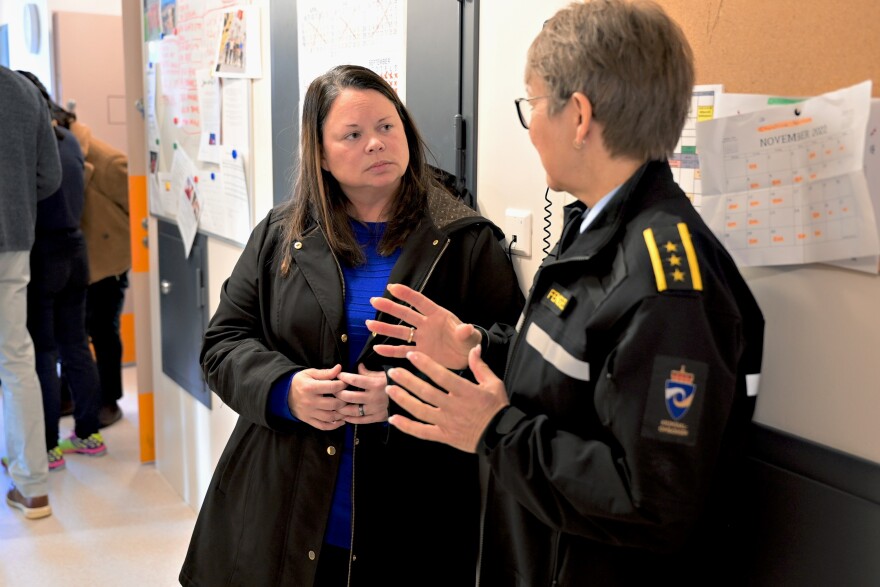The state of Connecticut is working to transform corrections. In November, a group of policymakers and thought leaders from across the state went to Norway to learn more about the success of their corrections system and how they could implement some of their methods at home.
Connecticut Public went to Norway and followed their journey, which is documented in Cutline: Transforming Corrections.
Warden Trina Sexton of York Correctional Institution went on the trip to Norway. York is the Connecticut Department of Correction's only prison for women across the state.
Sexton says Norway's societal view of incarceration is completely different from the United States.
"They were very accepting of those returning from incarceration," Sexton said. "And that acceptance is something that the entire community seems to embrace. They seem to understand that these are their neighbors. Their neighbors are coming back."
When our Accountability Project asked what Sexton hopes to implement from her visit to Norway, she said recently York added a playground to its facility to help strengthen relationships between incarcerated people and their families.
"We know from our own risk and needs assessments that familiar strength, the family, is a protective factor and that will protect against future recidivism," Sexton said. "It improves outcomes for everybody, not just those who are returning to the community, but their families, their children."
Sexton said York wants to continue implementing anything that supports the needs of the population.
The Norway trip isn't the first time Connecticut has considered prison reform.
In 2018, York opened a unit called W.O.R.T.H. It stands for Women Overcoming Recidivism Through Hard work. In this unit, incarcerated women who have been at York for a while work with younger women to rehabilitate them.
The whole prison has about 700 people and this unit has space for up to 60.
There's a similar unit for men at Cheshire Correctional Institution. Both were inspired by German and Scandinavian prisons after state officials took a trip there several years ago.
The goal is to focus on counseling, education and mentorship. To be placed in these units you have to apply.

Shannon Sampieri spent over 20 years incarcerated in general population at York and has been in the W.O.R.T.H. unit for the last three years as a mentor.
“I know comparatively in this unit, the types of codes that have ever been called, I don't even think there has been one compared to what goes on the other side," Sampieri said. "And I think it's because we're treated different. We're given different coping skills, we're given different ways to deal with things that we're not given on the other side."
Victoria Berube came to the unit as a mentee and is now a mentor. Like Sampieri, she says the difference between being incarcerated in general population and W.O.R.T.H. is night and day.
“There's no door on my cube. They're cubes, not cells," Berube said. "I have a service dog that I train. I order the supplies for the unit and run cleaning. I'm in college. I run groups and I interact with staff on the daily that I wouldn't normally do on the other side. On the other side, I was a tier worker, so I'd come out and clean twice a day. But that's really it.”
In Norway, all of their prisons have this unique focus.
Per Våge, a director in Norway’s correctional service, says the relationship between prison staff and incarcerated people in Norway is very different from many prison systems around the world.
“The sentence, that should not be the ticket to look down on those people," said Våge. "They have struggled in the society, done bad things. They have been convicted by the court, and then they should be treated like human beings in our facilities.”
There’s about 9,000 people incarcerated in Connecticut. About half of the incarcerated population returns to jail or prison within three years after they’re released.
In Norway, there about 3,000 people incarcerated. The country has about 2 million more people than Connecticut and their recidivism rate is about 20 percent.
But experts say you can’t make a direct comparison because there are many different factors.
A Connecticut Department of Correction district administrator Eulalia Garcia says it would take a cultural shift to make this kind of change at home.
“It’s not a DOC issue, right? It’s a systematic, it’s a societal issue," Garcia said. "Our culture norms are very different. In order to make a change, in the way that Norway has it would take quite some time because that’s something that our entire society would have to become accustomed to, a different way of life. It’s apples and oranges when you compare Norway in the United States.”
Learn more
A group of Connecticut policy makers and thought leaders toured prisons in Norway to learn best practices. Go along with them in Cutline: Transforming Corrections, which airs March 16 at 8 p.m. on CPTV. It re-airs March 18 at 1 p.m. on CPTV Spirit and 10 a.m. March 19 on CPTV, as well as 6 p.m. March 19 on CPTV Spirit.


